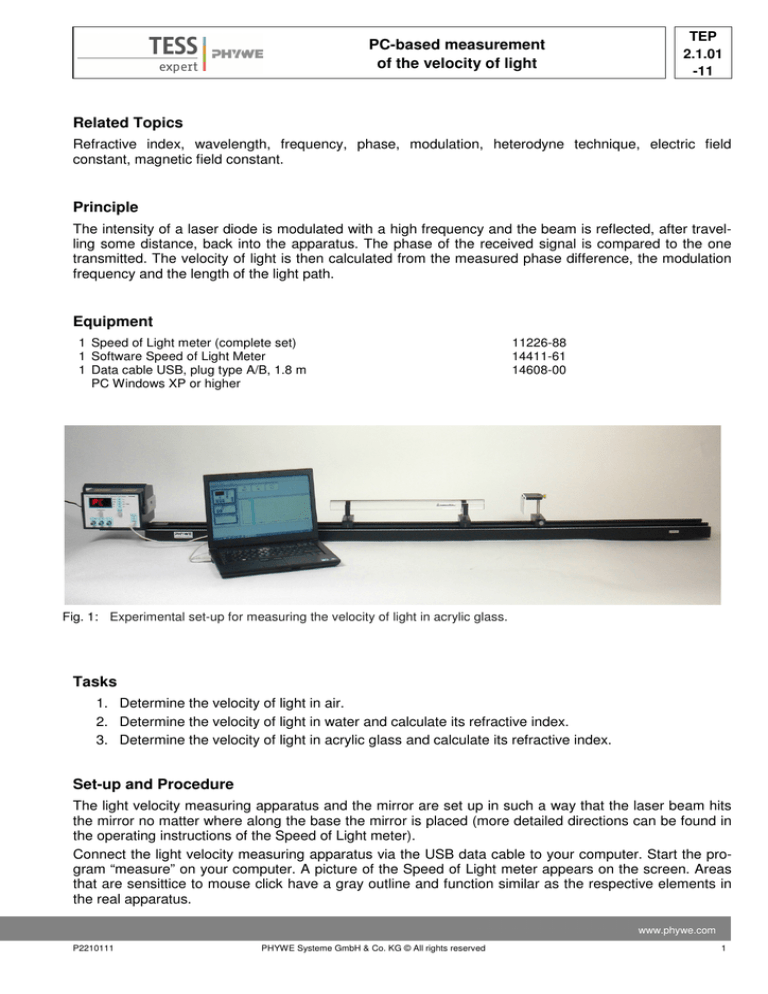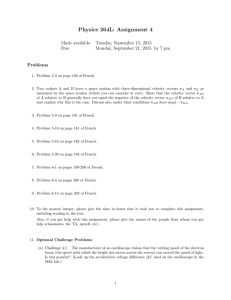
PC-based measurement
of the velocity of light
TEP
2.1.01
-11
Related Topics
Refractive index, wavelength, frequency, phase, modulation, heterodyne technique, electric field
constant, magnetic field constant.
Principle
The intensity of a laser diode is modulated with a high frequency and the beam is reflected, after travelling some distance, back into the apparatus. The phase of the received signal is compared to the one
transmitted. The velocity of light is then calculated from the measured phase difference, the modulation
frequency and the length of the light path.
Equipment
1 Speed of Light meter (complete set)
1 Software Speed of Light Meter
1 Data cable USB, plug type A/B, 1.8 m
PC Windows XP or higher
11226-88
14411-61
14608-00
Fig. 1: Experimental set-up for measuring the velocity of light in acrylic glass.
Tasks
1. Determine the velocity of light in air.
2. Determine the velocity of light in water and calculate its refractive index.
3. Determine the velocity of light in acrylic glass and calculate its refractive index.
Set-up and Procedure
The light velocity measuring apparatus and the mirror are set up in such a way that the laser beam hits
the mirror no matter where along the base the mirror is placed (more detailed directions can be found in
the operating instructions of the Speed of Light meter).
Connect the light velocity measuring apparatus via the USB data cable to your computer. Start the program “measure” on your computer. A picture of the Speed of Light meter appears on the screen. Areas
that are sensittice to mouse click have a gray outline and function similar as the respective elements in
the real apparatus.
www.phywe.com
P2210111
PHYWE Systeme GmbH & Co. KG © All rights reserved
1
TEP
2.1.01
-11
PC-based
based measurement
of the velocity of light
To toggle through the three modes of operation,
operation
click inside the dashed red rectangle shown in Fig
2. In the first mode the measured values for f in
MHz, Δφ in degree and Δt . 1000 in µs are shown.
Moreover, a virtual oscilloscope shows the screen
of an oscilloscope and Δt is determined from the
two signals like on a real oscilloscope (see Fig. 6).
In the second mode, Δx is shown. In the third
mode, the Speed of Light meter is in the manual
mode and the laser is shut off.
The virtual oscilloscope consists of a box in the
navigator-window
window where the virtual connections of
the oscilloscope are shown. Furthermore, the
screen of the virtual oscilloscope
cope is shown in the
program’s main window (see Figs 5 and 6).
6) You Fig. 4: The calibration button is marked with a red
can change the connections of the virtual oscillooscill
dashed circle
scope to the picture of the light velocity measuring
apparatus by clicking on the cables (see Fig 3,
dashed red rectangle). For more detailed descriptions: see instructions of the Software Speed of Light
Meter (14411-61). To determine Δt the virtual connections have to be set as shown in Fig. 3.
Fig. 2. Light velocity measuring apparatus and the virvi
tual oscilloscope on the screen.
2
Fig. 3. The connections of the virtual oscilloscope to the
apparatus.
PHYWE Systeme GmbH & Co. KG © All rights reserved
P2
P2210111
PC-based measurement
of the velocity of light
TEP
2.1.01
-11
Task 1: The velocity of light in air
Te begin with, the mirror is placed close to the operating unit you click in the area o the “calibration” button to have two coinciding signals visible on the virtual oscilloscope (see Figs. 4 and 5)
The mirror is then slid along the graduated scale. Measure for at least 10 different displacements Δx (>
100 cm) the time difference Δt. The difference is calculated automatically by the virtual oscilloscope (see
red rectangle in Fig. 6).
Task 2: The Velocity of light in water and Task 3: The Velocity of light in acrylic glass
Fig. 5. Virtual oscilloscope signal after “Calibration”.
Fig. 6. Measuring the time difference using the virtual oscilloscope.
The water-filled tube or the acrylic glass rod is placed so that the laser beam runs through them, the mirror is placed directly behind. The “Calibration” button is pressed. Again the virtual oscilloscope will show
a graph similar to Fig. 5. The tube/rod is then taken out of the path of the rays, the two signals will not
coincide any longer. Now the mirror is moved a distance Δx until the two signals on the virtual oscilloscope coincide again as before with the medium inserted. The mirror displacement Δx is measured several times.
www.phywe.com
P2210111
PHYWE Systeme GmbH & Co. KG © All rights reserved
3
TEP
2.1.01
-11
PC-based
based measurement
of the velocity of light
Theory and evaluation
Although light travels very fast, its velocity is finite.
fi
Since 1676 when Romer estimated the velocity of
light using spatial scales that included the distances
to the moons of Jupiter much technical development
took place. These days we can comfortably measure
measur
the speed of light on a table top. In the SI system, the
metre is defined as the distance
tance light travels in vacuum in 1/299792458 of a second. The effect of this
definition is to fix the speed of light in vacuum at exe
actly
299 792 458 m/s.
Task 1: Velocity of light in air:
To obtain the velocity
ity of light, one has calculate
Δt/Δs. Where Δt is the time the light takes to travel the
distance Δs. The distance Δs is 2· Δx because the additional stretch is twice the mirror displacement since
the laser beam has to travel to the mirror and back
again.
Table 1 gives an example of a measurement:
elocity of light in water/acrylic glass
Task 2: Velocity
The velocity of light in water or acrylic glass, cm, is
measured by comparing it with the velocity of light in
air ca (Fig. 7). In the first measurement (with the mem
dium), the light travels a distance l1 in time t1 (l1 =
2.x1).
Table 1
c = Δs/Δt
Δx in mm
Δs in mm
Δt in ns
1000
2000
6.6
3.03
1100
2200
7.3
3.01
1200
2400
7.9
3.03
1300
2600
8.6
3.02
1350
2700
9.0
3.00
1400
2800
9.3
3.01
1450
2900
9.6
3.02
1500
3000
9.9
3.03
1550
3100
10.3
3.01
1600
3200
10.6
3.02
av. val.: 3.018
In the second measurement (no medium), the light travels a distance l2 = l1 + 2Δx in the same time. This
means that the light takes the same time to travel the distance 2Δx + 2lm in air as it takes to travel the
distance 2lm in the medium.
From this and the definition of the refractive index, it follows directly, that
2∆ 2 ∆ 2
and
For the water-filled tube, with lm= 500 mm as the length of the water column and a measured Δx of
170 mm, this leads to:
n = 1.34, (literature value: nwater = 1.33)
cwater = 2.23 · 108 m/s
4
PHYWE Systeme GmbH & Co. KG © All rights reserved
8
in (m/s ·10 )
P2
P2210111
PC-based measurement
of the velocity of light
TEP
2.1.01
-11
For the acrylic glass cylinder, with lm= 490 mm and Δx = 240 mm:
n = 1.49, (literature values are in the range from: n = 1.48 to n = 1.52)
Fig. 7: Principle for measuring the velocity of light in a medium
cacrylic glass = 2.01 · 108 m/s
www.phywe.com
P2210111
PHYWE Systeme GmbH & Co. KG © All rights reserved
5


